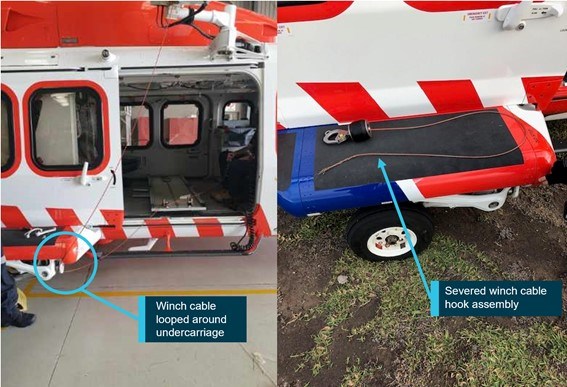SAR Hoist Cable Snag and Facture, Followed By Release of an Unserviceable Aircraft (AW139, Victoria, Australia)
On 15 December 2020 a Leonardo AW139 air ambulance helicopter was involved in two incidents while attempting to rescue three people stranded on a cliff near Childers Cove, Victoria, 19 km SE of Warrnambool Airport, at 19:00 Local Time.
The Australian Transport Safety Bureau (ATSB) report that the helicopter was being flown single pilot with an aircrew officer (winch operator) and a paramedic (winchman). ATSB do not identify the aircraft registration or the operator but images suggest an aircraft contracted by Ambulance Victoria, which online images suggest are only single hoist equipped.
Incident 1
The ATSB explain that:
The paramedic was winched to the ground and recovered the first stranded person. The aircrew officer then manoeuvred the paramedic and the first person into the aircraft cabin. To allow them to move into the aircraft seats, the aircrew officer winched out some cable to provide slack in the cable.
Crucially:
During this winch-out procedure, the slack cable was dispensed onto the aircraft floor and out the cabin door.
The aircrew officer was aware that the cable was outside the cabin, but not the length of cable that was outside the cabin, and the looped section was not visible.
When the aircrew officer commenced the winch-in of the hook assembly, the cable failed.
The aircrew officer secured the loose end of the winch cable and the pilot landed the helicopter in a nearby carpark to assess the situation.
Upon crew examination it was found that the hoist cable had looped around the right-hand main landing gear resulting in the failure of the cable and damage to several landing gear components.

Reconstruction of AW139 Hoist Cable Fouling and the Severed Cable and Hook Assembly (Credit: Annotated by ATSB)
No information is provided on when the remaining two individuals on the cliff were rescued.
Incident 2
An engineer was able to inspect the AW139 that evening in the car park shortly before last light. One might expect that even if nothing was said, there would be a perceived pressure to return the aircraft to its base to resume stand-by for the ambulance service as soon as practical.
The engineer cleared the aircraft to return to base. However, the ATSB say that…
…it was later determined that the damage to the undercarriage rendered the helicopter unserviceable.
Safety Actions
The ATSB choose not to conduct an investigation and have simply reported information supplied by the operator. ATSB say that the operator took three safety actions:
- A Safety Alert has been promulgated throughout the company to reinforce the importance of cable control during all phases of winching operations.
- All personnel have been reminded of the general safety philosophy of the company, which demands that safety related activities, including aircraft inspections and checks, are not rushed nor influenced by time pressures. Any activity should be stopped immediately if any person has any doubt about the safety in relation to a particular operation they are involved in.
- A learning package is being developed to facilitate sharing of the incident details and findings within the company and other helicopter emergency medical service operators.
In summary the actions were ‘an alert, ‘a reminder’ and a ‘learning package’.
Being prepared to share the learning package more widely is to be highly commended.
Readers who become involved in a similar situation could usefully examine the effectiveness of prior training and competence assessment, the appropriateness of procedures, communications with the crew in the field and relevant organisational norms.
Safety Resources
The European Safety Promotion Network Rotorcraft (ESPN-R) has a helicopter safety discussion group on LinkedIn. You may also find these Aerossurance articles of interest:
- TCM’s Fall from SAR AW139 Doorway While Commencing Night Hoist Training
- SAR AW139 Dropped Object: Attachment of New Hook Weight
- Swedish SAR AW139 Damaged in Aborted Take-off Training Exercise
- SAR Helicopter Loss of Control at Night: ATSB Report
- Military SAR H225M Caracal Double Hoist Fatality Accident
- Marine Pilot Transfer Winching Accident: referenced in the Royal College of Art (RCA) & Lloyd’s Register Foundation Safety Grand Challenge: Safe Ship Boarding & Thames Safest River 2030
- Fatal Fall From B429 During Helicopter Hoist Training
- Hoist Assembly Errors: SAR Personnel Dropped Into Sea A UH-60M accident in Taiwan during a SAR exercise.
- USAF Helicopter Hoist Training Accident: equipment snagged on obstacle
- Fall From Stretcher During Taiwanese SAR Mission (NASC AS365N2 NA-104)
- Fatal Taiwanese Night SAR Hoist Mission (NASC AS365N3 NA-106)
- Fatal Powerline Human External Cargo Flight
- SAR Crew With High Workload Land Wheels Up on Beach
- Night Offshore Windfarm HEMS Winch Training CFIT (BK117C1 D-HDRJ)
- NH90 Caribbean Loss of Control – Inflight, Water Impact and Survivability Issues
- SAR AW101 Roll-Over: Entry Into Service Involved “Persistently Elevated and Confusing Operational Risk”
- UPDATE 26 November 2022: Guarding Against a Hoist Cable Cut
- UPDATE 14 May 2023: HH-60L Hoist Cable Damage Highlights Need for Cable Guards

Recent Comments